Sprouts Farmers Market closes $600 million revolving credit facility
Introduction & Market Context
Acadia Pharmaceuticals (NASDAQ:ACAD) presented its first quarter 2025 financial results on May 7, showcasing strong performance across its commercial portfolio. The biopharmaceutical company, focused on central nervous system disorders and rare diseases, reported total revenue of $244.3 million, representing a 19% year-over-year increase. The stock responded positively to the results, with shares rising 1.86% in regular trading and adding another 1.35% in after-hours trading to reach $15.01.
The company’s performance continues to be driven by its two flagship products: Nuplazid (pimavanserin) for Parkinson’s disease psychosis and Daybue (trofinetide) for Rett syndrome. With both products showing double-digit growth, Acadia remains on track to exceed $1 billion in annual revenue for the first time in 2025.
Quarterly Performance Highlights
Acadia’s Q1 2025 results demonstrated robust growth across key metrics. Total (EPA:TTEF) revenue reached $244.3 million, up 19% from the same period last year. This growth was primarily driven by Nuplazid, which generated $159.7 million in sales (up 23% year-over-year) and Daybue, which contributed $84.6 million (up 11% year-over-year).
As shown in the following financial highlights table:
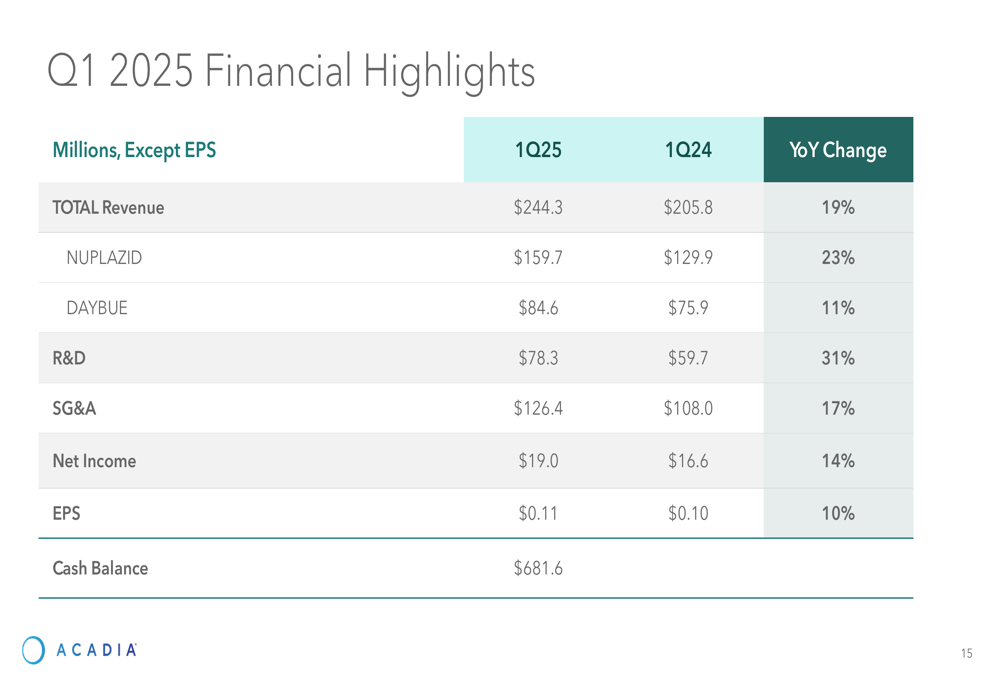
The company reported net income of $19.0 million for the quarter, representing a 14% increase compared to Q1 2024. Earnings per share reached $0.11, up 10% year-over-year. These results reflect Acadia’s continued commercial execution despite increased investments in research and development, which rose 31% to $78.3 million.
Daybue’s performance showed particularly encouraging signs regarding patient retention. The company reported that 954 unique patients received Daybue during the quarter, with discontinuations down 35% compared to Q4 2024 and 66% compared to Q1 2024. Importantly, 65% of active patients have now been on therapy for 12 months or longer, indicating strong persistency rates above 50% at the one-year mark.
The following slide details Daybue’s quarterly performance:
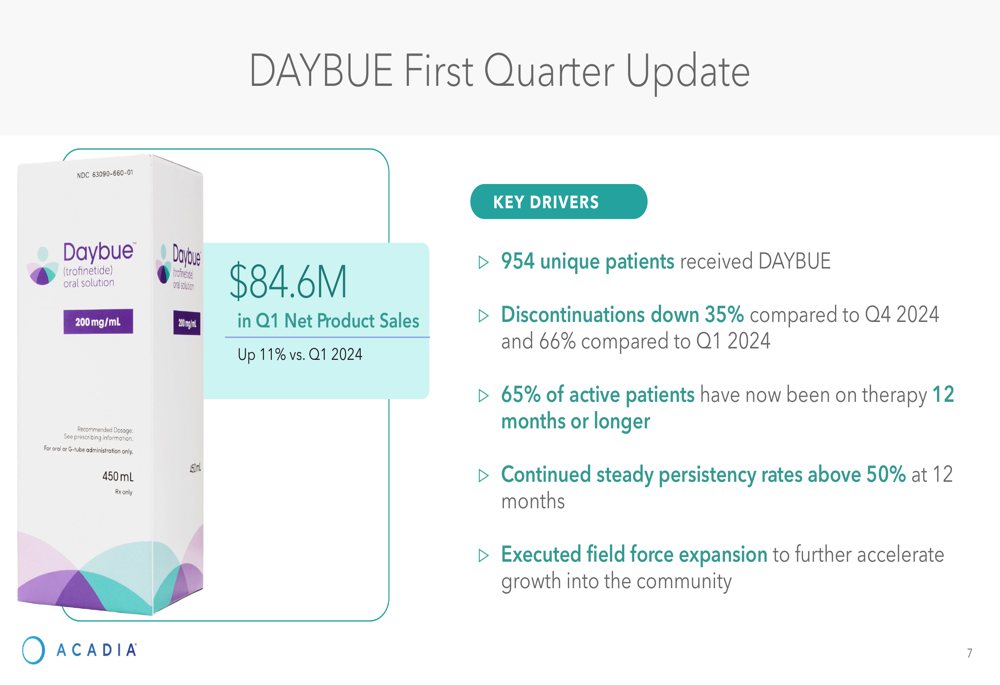
Meanwhile, Nuplazid achieved its highest-ever quarterly sales, benefiting from increased awareness campaigns and leveraging real-world evidence showing lower all-cause mortality, hospitalizations, and emergency room visits among patients using the medication.
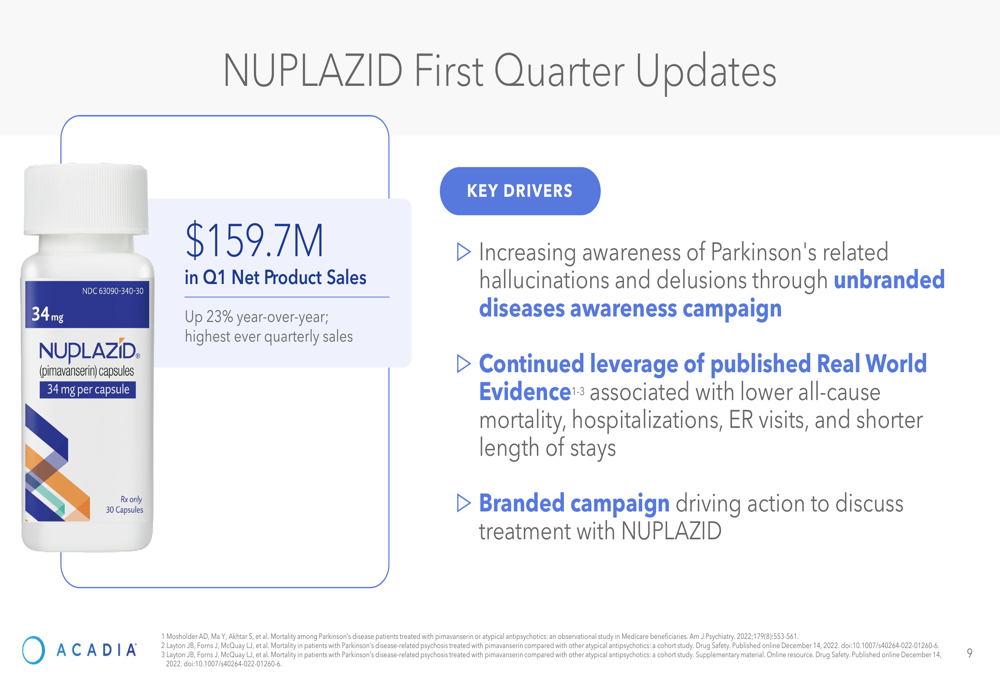
Detailed Financial Analysis
Acadia maintains a strong financial position with a cash balance of $681.6 million as of March 31, 2025. This represents a decrease from the $756 million reported at the end of 2024, likely reflecting ongoing investments in research and development and commercial expansion.
For the full year 2025, Acadia provided the following financial guidance:
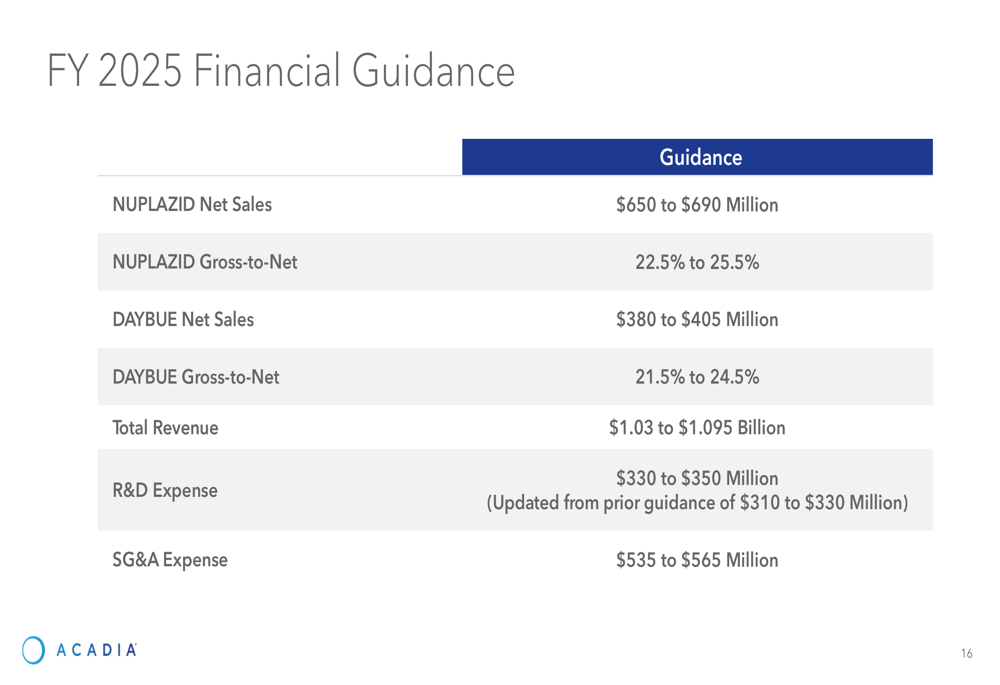
The company expects total revenue between $1.03 billion and $1.095 billion for 2025, with Nuplazid sales projected at $650-690 million and Daybue sales at $380-405 million. Notably, Acadia has increased its R&D expense guidance to $330-350 million from the previous $310-330 million, reflecting accelerated development timelines and expanded pipeline activities.
SG&A expenses are projected to be between $535-565 million for the year, supporting commercial expansion efforts both domestically and internationally. The gross-to-net ratio is expected to remain relatively stable for both products, with Nuplazid at 22.5-25.5% and Daybue at 21.5-24.5%.
Strategic Initiatives & Pipeline Updates
A significant highlight from the presentation was the accelerated timeline for ACP-101 in Prader-Willi Syndrome (PWS). The company now expects the last patient to enter the COMPASS PWS Phase 3 trial in Q2 2025, with topline results anticipated in early Q4 2025. Assuming positive data, Acadia plans to file a New Drug Application (NDA) in Q1 2026, with potential approval by Q3 2026.
The following slide illustrates this accelerated timeline:
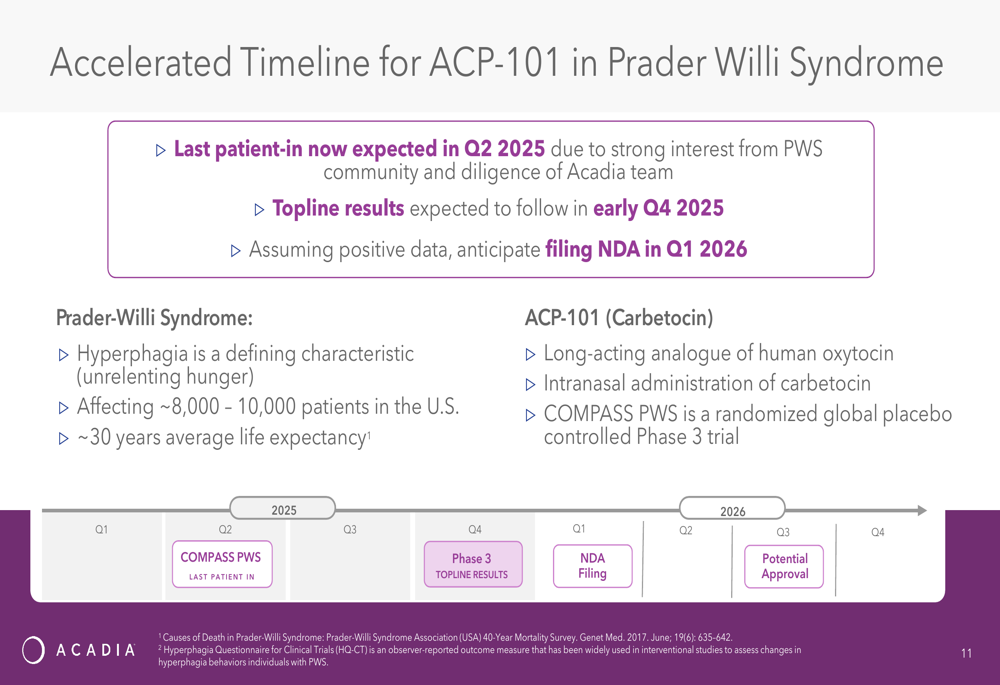
Acadia is also advancing its global expansion strategy for Daybue. The company has filed a Marketing Authorization Application with the European Medicines Agency and anticipates approval in Q1 2026. Additionally, Acadia has established managed access programs in certain countries, including Germany, and signed distribution agreements to facilitate named patient supply in Latin America, the Middle East, and Asia Pacific regions.
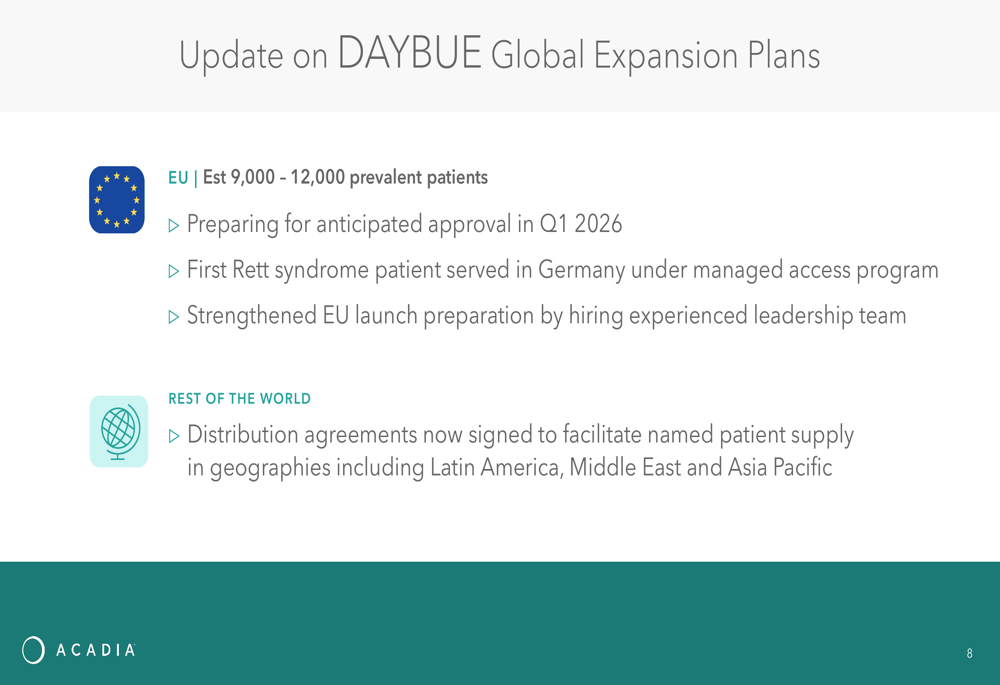
The company’s pipeline continues to expand beyond its two commercial products. ACP-204, a new 5HT2A inverse agonist, is advancing in Phase 2 studies for both Alzheimer’s Disease Psychosis and Lewy Body Dementia Psychosis. The company plans to initiate a Phase 2 study in Lewy Body Dementia Psychosis in Q3 2025.
Acadia’s comprehensive pipeline across CNS and rare diseases is illustrated below:

Forward-Looking Statements
Looking ahead, Acadia has outlined several key milestones for 2025-2026:
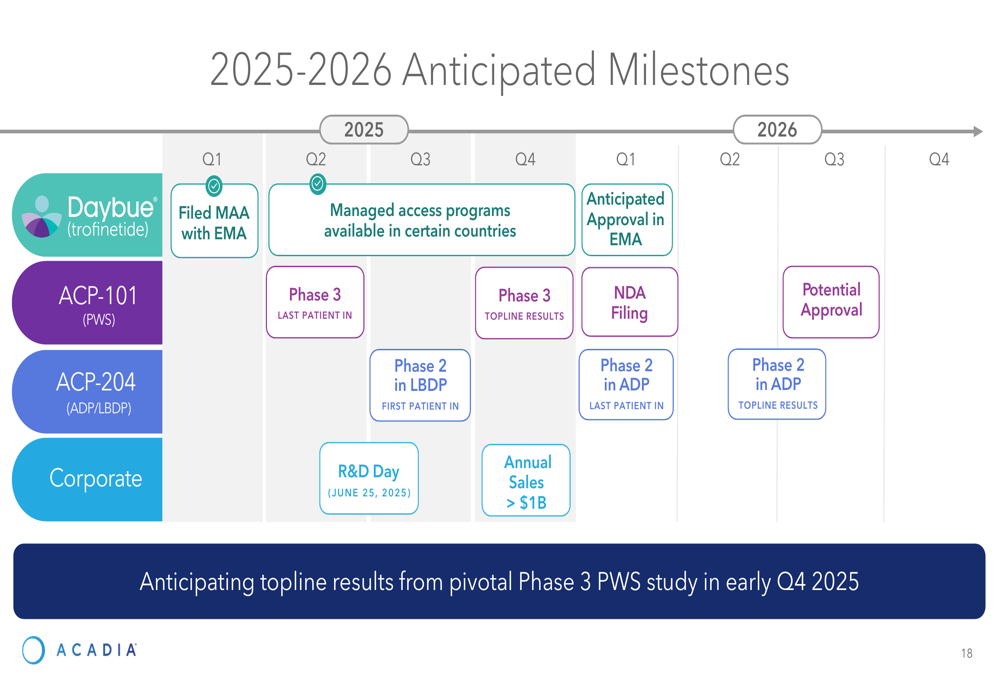
The company expects to achieve annual sales exceeding $1 billion by Q4 2025, representing a significant milestone in its commercial evolution. Additionally, Acadia plans to host an R&D Day on June 25, 2025, where it will provide more details on its pipeline programs.
CEO Catherine Owen Adams emphasized the company’s growth trajectory during the earnings call, noting that 2025 marks "a new era for Acadia" where they intend to drive substantial growth in commercial brands to over $1 billion. This aligns with statements from the previous quarter’s earnings call, indicating consistent execution of the company’s strategic plan.
With multiple potential catalysts on the horizon, including the anticipated topline results from the pivotal Phase 3 PWS study in early Q4 2025, Acadia appears well-positioned to maintain its growth momentum through 2025 and into 2026. The company’s diversified pipeline, expanding global footprint, and strong commercial execution provide multiple avenues for continued revenue growth and pipeline advancement.
Full presentation:
This article was generated with the support of AI and reviewed by an editor. For more information see our T&C.
